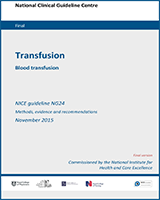| No. of patients receiving allogeneic transfusions (route) | 626
(4 studies) | VERY LOWa,b
due to risk of bias, imprecision | RR 0.83
(0.3 to 2.29) | Study population |
| 23 per 1000 | 4 fewer per 1000
(from 16 fewer to 29 more) |
| No. of patients receiving allogeneic transfusions (route) - Topical TXA | 400
(1 study) | VERY LOWa,b
due to risk of bias, imprecision | RR 0.2
(0.01 to 4.14) | Study population |
| 10 per 1000 | 8 fewer per 1000
(from 10 fewer to 31 more) |
| No. of patients receiving allogeneic transfusions (route) - Oral TXA | 136
(1 study) | VERY LOWa,b
due to risk of bias, imprecision | RR 1.13
(0.36 to 3.53) | Study population |
| 76 per 1000 | 10 more per 1000
(from 48 fewer to 192 more) |
| Blood loss (type of surgery-topical TXA)) -Orthognathic surgery | 0
(1 study) | MODERATEa
due to risk of bias | | | The mean blood loss (type of surgery-topical TXA) -orthognathic surgery in the intervention groups was 0.93 higher
(0.73 to 1.2 higher) |
| Blood loss (type of surgery-topical TXA) - otolaryngeal surgery | 0
(2 studies) | | | | The mean blood loss (type of surgery-topical TXA) - otolaryngeal surgery in the intervention groups was 0.74 higher
(0.73 to 0.76 higher) |
